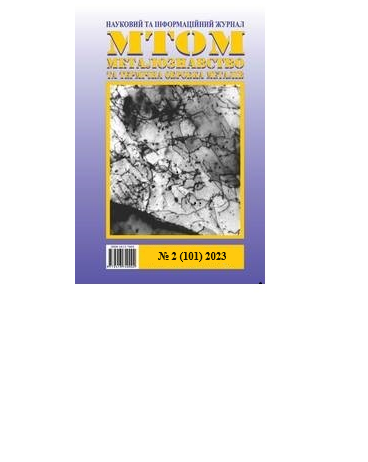ON COMPETING PROCESSES AT THE INCLUSION – MATRIX BOUNDARIES DURING STEEL ROLLING
DOI:
https://doi.org/10.30838/J.PMHTM.2413.040723.39.982Keywords:
steel, non-metallic inclusions, interphase boundaries, interphase friction, interphase slipping, deformationAbstract
Purpose of the work – to study of the processes that determine the interaction of non-metallic inclusions and the steel matrix during steel rolling. Methods. The behavior of inclusions was studied during hot rolling of steels 08Yu, 08T, 08kp, NB-57, 08GSYUTF in the temperature range of 1 200...900 °C and cold rolling with degrees of deformation of 35...75 %. The study of hot slipping along the boundaries of the inclusion − matrix was observed during high-temperature (900...1 200 °C) deformation by stretching in a vacuum on the IMASH-5S installation with a gripper movement speed of 1 680 mm/min. According to the study of slipping, steel samples were stretched in a vacuum at temperatures of 25...900 °С on the IMASH-5S installation with a gripper movement speed of 2 000 mm/min. On the surface of the samples, using the PMT-3 device, reference points were applied near the 0° and 90° inclusion poles on both sides of the inclusion − matrix boundary. Research methods are given in works [10; 11]. Identification of inclusions was carried out by metallographic (Neophot-31), petrographic and micro-X-ray spectral (MS-46 Cameca) methods. Results. It is shown that during plastic deformation, there is an interaction between non-metallic inclusions and the steel matrix, which determines their joint plastic shape change and is associated with the development of competing processes at the inclusion − matrix interphase boundaries: interphase friction and slipping (hot or cold depending on the deformation temperature). The mechanisms of these processes are determined depending on the deformation conditions and the level of plasticity of non-metallic inclusions and the steel matrix. Scientific novelty. The peculiarities of interphase friction and hot and cold slipping along the inclusion − matrix interphase boundaries of steel under different conditions of plastic deformation have been established. It is shown that the mechanisms of each of these processes depend on the temperature regime of deformation, the level of plasticity of the inclusions and the steel matrix, as well as on the structure of the inclusion − matrix boundaries, which determines the possibilities of movement and interaction of interfacial defects. It is shown that the specified processes determine the level of plasticity of the inclusion − matrix boundaries and significantly affect the nature of the change in shape of the inclusions and their redistribution in the steel matrix during steel rolling, which inevitably affects the technological plasticity of steels. Practical significance. The use of the results obtained will make it possible to develop technologies for producing steels with regulated types of nonmetallic inclusions, which will significantly increase their technological characteristics, as well as prevent the formation of various kinds of defects during the processing of steels by pressure of products.
Downloads
Published
Issue
Section
License
Authors that are published in this journal agree to follow the conditions:
Authors reserve the right to the authorship of his work and cede the right to the journal of first publication of this work on conditions of the license under the Creative Commons Attribution License, which allows others to distribute it freely with the obligatory reference to the author of the original work and the first publication of the work in this journal.

